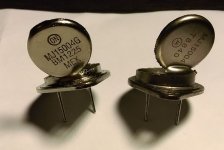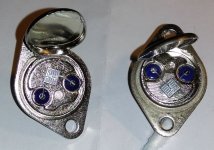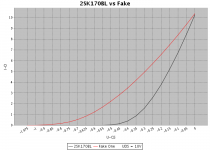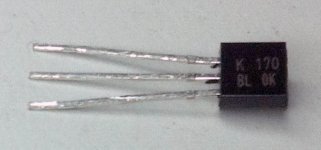New and old MJ15004
I have opened an old MJ15004 from 1988. I hope that back then there was no fake transistor and this one is geniune. So I took pictures of old one and new one side by side, one picture where you can see markings and one picture where you can see inside.
If transistor from 1988 is original, could I say that new one is original too? And could we use opened transistor from 1988 for help to identify other transistors?
Best regards,
Ivo
I have opened an old MJ15004 from 1988. I hope that back then there was no fake transistor and this one is geniune. So I took pictures of old one and new one side by side, one picture where you can see markings and one picture where you can see inside.
If transistor from 1988 is original, could I say that new one is original too? And could we use opened transistor from 1988 for help to identify other transistors?
Best regards,
Ivo
Attachments
I have opened an old MJ15004 from 1988. I hope that back then there was no fake transistor and this one is geniune. So I took pictures of old one and new one side by side, one picture where you can see markings and one picture where you can see inside.
If transistor from 1988 is original, could I say that new one is original too? And could we use opened transistor from 1988 for help to identify other transistors?
Best regards,
Ivo
Yes the new one is genuine!!!
15003/4 are 200 watt, not 250. 2N3773 is rated 150 watt, but has very high SOA and acts more like a 200 watt (or even 250 watt) device. And if you compare some of the graphs in the data sheets on these and other similar types like the 5630, it is quite obvious that they just copied the data plot. Sometimes the same device is tested to different specs under different conditions, and gets a unique type number. Many share the same mask set and only differ slightly in the processing. I have some old aluminum cased 2N6030's from 1980 that the dies look absolutely identical to those 15004's.
Once I got a batch of fake MJ15024's. The leads didn't solder well, and that should have been the first clue. The second was that the parallel batch didn't even come close to biasing up evenly. Same date code - that never happens. Popped the covers and no two were the same. They varied from looking just like your 15004 to those little bitty 2 mm devices you typically find in fakes. Some had white silicone goo some didn't. I wonder how they were able to program the machines to obviously handle different material - in the same run. Unless they built them by hand - which wouldn't have been exactly cheap.
Once I got a batch of fake MJ15024's. The leads didn't solder well, and that should have been the first clue. The second was that the parallel batch didn't even come close to biasing up evenly. Same date code - that never happens. Popped the covers and no two were the same. They varied from looking just like your 15004 to those little bitty 2 mm devices you typically find in fakes. Some had white silicone goo some didn't. I wonder how they were able to program the machines to obviously handle different material - in the same run. Unless they built them by hand - which wouldn't have been exactly cheap.
I needed K170/J74 jfets and K1085/J162 mosfets but couldn't find reliable source and ended up purchasing from ebay. I am not sure if I got genuine, but they work anyway.
Some good audio transistors are so hard to get. Sorry I don't try to threadjack, but since it is relevant, it will be great for some recommendation for easy-to-source (from DK or Mouser, etc) audio transistors.
Some good audio transistors are so hard to get. Sorry I don't try to threadjack, but since it is relevant, it will be great for some recommendation for easy-to-source (from DK or Mouser, etc) audio transistors.
mj15003/4 are specified as 250W devices by ONsemi.15003/4 are 200 watt, not 250. ...............
20 AMPERE
POWER TRANSISTORS
COMPLEMENTARY SILICON
140 VOLTS, 250 WATTS
Are the 2SK2013 in this auction obviously fake? I purchased some from him along with some 2SJ313 (which appear genuine), but did not carefully check the picture first. The seller has good feedback and has been promoted in the past here on the forums. The transistors I received match the picture exactly, but I was not aware of Toshiba using '216' as a date code. Can anyone confirm these are fake? I have not tested them yet due to lack of time.
They should be hard on at 5V. This sounds more like a conventional vertical mosfetThese 2SK2013 do not appear to be genuine. Putting 2.5Vgs should give around 300mA through the FET according to the datasheet, but I get no current. The FETs don't appear to turn on until they have nearly 5Vgs. I will contact the seller.
Yep. The 2SJ313 I bought from him share the same problem, even though they look slightly more genuine. So, we need to look elsewhere for 2SJ313/2SK2013.
I sent the seller, activeparts, a courteous 'FYI these parts appear to be fake' email last night and did not ask for a refund, but he responded and sent a refund first thing this morning. No harm done and the seller appears to be a stand-up guy.
I sent the seller, activeparts, a courteous 'FYI these parts appear to be fake' email last night and did not ask for a refund, but he responded and sent a refund first thing this morning. No harm done and the seller appears to be a stand-up guy.
Another Fake 2SK170BL
I recently bought 50 Pieces 2SK170BL from this ebay auktion
50PCS 2SK170-BL Manu:TOSHIBA Encapsulation:TO-92,TRANSISTOR | JFET | | eBay
Aware they are way to cheap to be real Toshiba's I asked the seller that I can't believe that they are genuine. The answer was that he don't sell any fake items and if so a refund is guaranteed.
I recently bought 50 Pieces 2SK170BL from this ebay auktion
50PCS 2SK170-BL Manu:TOSHIBA Encapsulation:TO-92,TRANSISTOR | JFET | | eBay
Aware they are way to cheap to be real Toshiba's I asked the seller that I can't believe that they are genuine. The answer was that he don't sell any fake items and if so a refund is guaranteed.
Just for fun I bought this batch and they arrived pretty soon. Indeed they look pretty like my genuine ones from alweit, they are lasered and IDss is fine with ~10mA for a BL grade. I also read VGDS arround -40V and PD > 300mW. Unfortunately I read VGS (OFF) at -1.04V So obviously they are faked but still they are not that bad. I have a bad feeling regarding the noise figure but I'll keep them for some test purposes. If somebody would like to perform some further tests, pm me. I'll happy to send a sample.
Keep going Guys,
smartdrive
Keep going Guys,
smartdrive
Attachments
Try B+D Enterprises - Home page For hard to find semiconductors. Not cheap , but what I 'save gotten for the 10 years or so has been good.
mj15003/4 are specified as 250W devices by ONsemi.
Thanks Andrew... That's what my old man memory thought as well. The Motorola parts were so robust, that I remember making a sub amp with these devices, running at +/- 92v rails. This is a good 30% over what they were usually run at. Sure a couple of devices failed, but I had loads of them, and after a few failed parts (4 pairs into an 8 ohm load), the rest were just fine.
Fakes are normally miles off, relabelled 2n3819 etc or even bipolar transistors.
These look like a serious attempt at a second source, maybe LSK170 relabelled if the price difference is worth it
Probably there is a Chinese foundry that makes the ones ending with OK in a an aspiring cloning attempt while providing some legit Chinese Toshiba stockists channel.
I had checked some K117 ending OK with same as the K170 in the photo "1" printing (Toshiba used "|") before a year or two. After I found them off enough and I let him know, the seller was adamant that he gets them legitimately from a channel he named "Toshiba China". He backed up his assertion by buying a new batch and resending from those cost free to me. Same deviations happened nonetheless. If the Id vs Vds curves are also slanting up the more with the higher the id vs the originals (along with the higher Vgs(OFF) trend already shown) then its the same cloning style production. Another trend is they lose Idds faster when provided with <10V VDS than in what rate it happens with the originals as the VDS is going down.
LSK would be even more expensive to relabel than selling NOS originals first hand due to its far smaller production volume than when the original part was produced. LSK is not a cheap JFET in general, and not widely available in Asia, rather special to find stock in the West even. But it could have "inspired" the "Toshiba China" part.
- Home
- Design & Build
- Parts
- My Transistors, original or copy?



